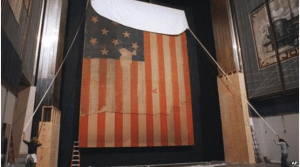

By Ted Landphair – This is a really big year at Fort McHenry, a star-shaped fortification overlooking the harbor in Baltimore, Maryland.
Only in America-Fort McHenry Flag
But at dawn, as Francis Scott Key, a Washington lawyer who observed the shelling, wrote in a poem, a miraculous visage of “broad stripes and bright stars” of the U.S. flag appeared, still “gallantly streaming” over Fort McHenry.
 An aerial view of Fort McHenry. The 15-star flag shown is current, but it approximates the oversized flag that flew over the fort during the fateful bombardment of 1814. (National Park Service)
An aerial view of Fort McHenry. The 15-star flag shown is current, but it approximates the oversized flag that flew over the fort during the fateful bombardment of 1814. (National Park Service)Thwarted and out of ammunition, the British sailed away and Key’s verses became the words to the U.S. national anthem, “The Star-Spangled Banner.”
As for the largest battle flag ever flown at the time, which Fort McHenry’s commandant, Lt. Col. George Armistead, had ordered raised as a defiant symbol of resistance: It survived, shot full of holes.
Col. Armistead kept it and allowed several pieces, including one of its 15 stars, to be snipped off and given away as souvenirs.
 A soldier guards the original Fort McHenry. Note his size and that of the flag. (Wikipedia Commons)
A soldier guards the original Fort McHenry. Note his size and that of the flag. (Wikipedia Commons)In 1912, what was left of the flag was presented to the Smithsonian Institution in Washington. After many restorations, it is front and center at the National Museum of American History.
And on Flag Day, June 14, this year, three red threads from the historic Fort McHenry flag were sewn into the “National 9/11” flag, a tattered remnant of an even more terrible attack on the United States by terrorists, who brought down the World Trade Center’s Twin Towers in New York on Sept. 11, 2001.
That 9/11 flag is currently on tour and will end up on display in the Sept. 11 Memorial that is being built at Ground Zero where the towers once stood.
The threads came from seven small patches of the original Fort McHenry flag that are held by the Star-Spangled Banner House Museum in Baltimore.
